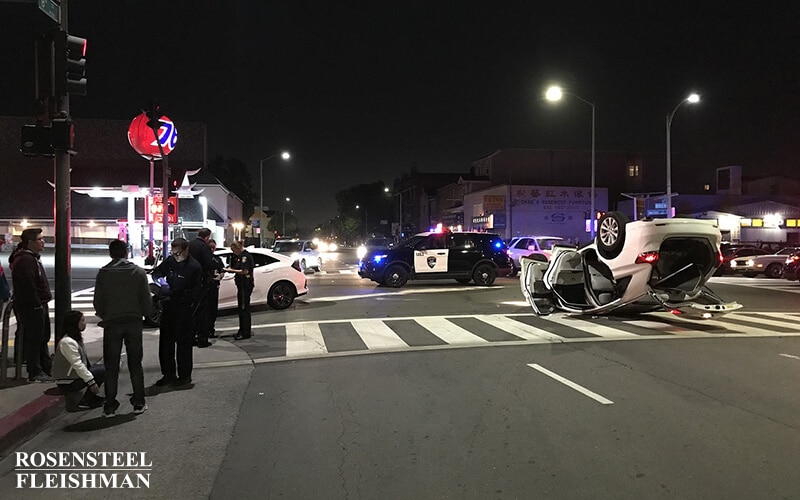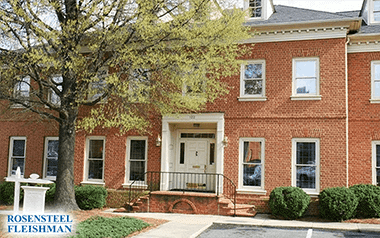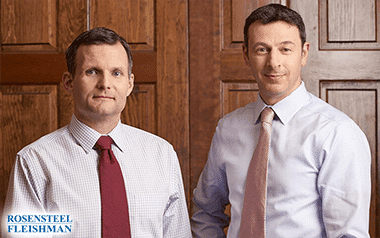Contributory Negligence Lawyer for Car Accident Cases

While the law of contributory negligence is very strict, there are ways around it. Over the years there have been thousands of cases dealing with different facets of contributory negligence. This is why it is important to discuss your case with a skilled Charlotte personal injury lawyer at Rosensteel Fleishman Car Accident & Injury Lawyers. Our lawyers know what facts to look out for to help your case. Further, our lawyers have access to the latest technology to examine up to the minute changes in the law.
Contributory negligence is a very complex law which has been misconstrued by claimants, lawyers and insurance adjusters alike. To add to the complexity there are two types of contributory negligence. The first, deals with the negligent actions of the plaintiff as a bar to recovery as a question of fact, i.e. to be determined by a jury. The second contributory negligence deals with the actions of the plaintiff as a matter of law. An example of the later is if you get into a vehicle with someone who you know or should know is intoxicated. As a matter of law you are deemed to be contributorily negligent.
For this article we will focus on the former type of contributory negligence, as it also is the most common (and most misconstrued). By way of example we will assume a car accident in Charlotte, North Carolina involving two vehicles. For this accident there are two witnesses who saw the Plaintiff speeding and saw the defendant run a red light. The collision took place when the Plaintiff T-Boned the Defendants vehicle.
It is not unusual for insurance companies, hearing the above fact pattern to deny the Plaintiff’s claims. They will typically allege that the Plaintiff’s speeding was negligent, and as such they are barred from recovery. While this is a misstatement of the law, unfortunately for many injured people this is where they stop pursuing their case.
Even if the contributory negligence is a proximate cause of the accident this is not the end of the investigation. North Carolina has a statute referred to as Last Clear Chance. The jury instruction for Last Clear Chance reads – Did the Plaintiff by his own negligence put himself in a position of peril for which he could not escape and did the Defendant have the last clear chance to avoid the accident?
Looking For A Charlotte Lawyer Near You?
To determine Last Clear Chance the jury would have to parse the jury instruction and answer three questions (all of which are the Plaintiff’s burden to prove): (1)Did the Plaintiff by his own negligence put himself in a position of peril (2)for which he could not escape (3)and did the Defendant have the last clear chance to avoid the accident?
A recent case we handled highlights the Last Clear Chance argument. Our client was riding his bicycle at night in Charlotte without any reflective gear or lights. There was no moon but the weather was clear. The road was flat and straight for approximately 800 feet behind the plaintiff. The defendant was driving his vehicle behind the plaintiff when he ran into the back of the bicycle. The plaintiff did not hear the defendant’s car before being hit. The claim was denied by the insurance company prior to our office becoming involved.
The successful argument we made during the course of litigation was that even though the Plaintiff was operating his bicycle in violation of the North Carolina statutes (which require reflectors on bicycles) the defendant had the Last Clear Chance to avoid the accident. Clearly the plaintiff by his own negligence put himself in a position of peril. He was riding his bicycle without lights. He could not see or hear the defendants vehicle prior to the impact and as such he could not escape the situation. Our engineer performed a reconstruction thereby proving that the defendant would have been able to see the bicycle that night had he been paying attention.
As such, even though plaintiff was negligent we still had a successful settlement of the case arguing Last Clear Chance. Last Clear Chance is a very complex law. There are dozens of appellate cases dealing with each element of the law. Each case is fact specific. Many times it comes down to what the parties said following the accident. This is why it is highly suggested not to speak with any insurance company following a car accident. To discuss your case please contact us for a free no obligation consultation.
North Carolina Contributory Negligence Example
In almost every North Carolina personal injury case there are three possible jury questions:
1. Has the Plaintiff proved the defendant acted negligently;
2. Has the Defendant proved that the Plaintiff contributed, in any way, to causing their own injury; and
3. What, if any, amount is Plaintiff entitled to for damages.
It is the second question that we are going to examine in this article. North Carolina has a theory of law known as contributory negligence. In essence, it is defined as negligence on the part of the Plaintiff (the injured party) which may have played some part in causing the incident which resulted in the injury complained of.
A common example of this is seen in when examining North Carolina auto accidents. For example, take two cars, Car A and Car B. Car A is driving straight approaching an intersection. The speed limit is 35 mph but the Car is going 47mph. Car A does not have a stop sign.
Car B is approaching the same intersection from the side street. Car B has the stop sign but does not stop. Car B runs the stop sign and enters the intersection thereby failing to yield the right of way to Car A. A collision occurs between Car A and Car B.
Factual Analysis of Car B
Now, in our example most people would agree that Car B, by running the stop sign, was the major cause of the car accident. In negligence terms it can be argued that a reasonable person who has control of their car would stop when they get to a stop sign. Therefore the driver of Car B would be negligent by failing to come to a complete stop at the stop sign. Further, the driver of Car B would be negligent in failing to yield the right of way to Car A.
Factual Analysis of Car A
In our example it is a fact that Car A was speeding. As such, it can be argued that maybe if Car A wasn’t speeding they could have avoided the wreck, slowed done beforehand, etc. In terms of negligence, a reasonable person approaching an intersection would be on the lookout for another car. Further, while it can be argued that the average person does exceed the speed limit as a matter of course it becomes a jury question whether exceeding the speed limit by 12 mph is reasonable or negligent.
Why Hire a Contributory Negligence Lawyer?
Most people would agree that in our example the main cause of the wreck was Car B’s failing to stop at the stop sign. As such, maybe Car B is 95% – 99% negligent. Concurrently, Car A may be negligent as well for its excessive speed, maybe 1% – 5% negligent.
Under North Carolina law, if the driver of Car A is even just 1% negligent (and that negligence was a proximate cause in the accident), they are unable to recover money damages.
While the law of contributory negligence is very strict, there are ways around it. Over the years there have been thousands of cases dealing with different facets of contributory negligence. This is why it is important to discuss your case with a skilled Charlotte personal injury lawyer at Rosensteel Fleishman. Our lawyers know what facts to look out for to help your case. Further, our lawyers have access to the latest technology to examine up to the minute changes in the law.
Speak to a Charlotte, NC Car Accident Lawyer Today
Our car accident attorneys have recovered millions of dollars for clients throughout North Carolina. Whether you were injured in an auto accident or a slip and fall, our job is to pursue the most appropriate resolution for each individual client. Whether that’s through a settlement, an arbitration, or a jury trial, the client is informed and in control from start to finish.
Our fee structure is designed to put the money where it belongs, in the pocket of the client. At the end of your case you will receive a summary, to the penny, of where every dollar is going.
Our lawyers also handle our client’s property damage claim, free of charge, as a favor to our client. For more information on North Carolina Property damage please NC automobile accidents and property damage.
Call (704) 714-1450 to make an appointment to speak with a Charlotte personal injury attorney or stop by the office during regular business hours. We understand that the last thing you need to do at this time is miss a doctor’s appointment or more time from work. We will schedule an appointment that fits your needs. There is no fee for the initial consultation. Whether you call, come in the office or request a home visit you will speak directly with a personal injury attorney who can answer your questions.

